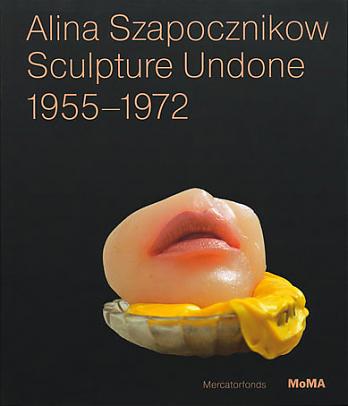Alina Szapocznikow. Sculpture Undone 1955-1972
Alina Szapocznikow has left behind remarkably moving work, a pioneer legacy which is now, forty years after her death, entering the canon of 20th century art.
Alina Szapocznikow. Sculpture Undone. 1955–1972 is a catalog edited by the Museum of Modern Art in New York to document a monographic exhibition dedicated to the artist, authored by Joanna Mytkowska and Elena Filipovic.
The insightful texts are authored by: Joanna Mytkowska, Elena Filipovic, Connie Butler and Allegra Pesenti. A new timeline of Szapocznikow’s life and work was prepared by Jola Gola and extensively illustrated with photographs from the artist’s archive.
Alina Szapocznikow was born in 1926 in Kalisz, into a family of assimilated Jews. She survived the war along with her mother in the Lodz ghetto, and later in concentration camps. After the war, she studied in Prague and Paris. In the 1950s, she returned to Poland and won great critical acclaim as a sculptor. In 1963, she emigrated to France, where she died ten years later, aged 47. The brilliance and power of her artwork – sculptures and drawings – still amaze with how they present the personal history of the artist, her pursuits and obsessions, as well as a more general frame of her mind – a struggle with the challenges of contemporary times. “I only make awkward objects” is what she wrote in her artistic manifesto, shortly before her death.
Up until the late 1950s, Szapocznikow had been an acknowledged and frequently presented artist in Poland. Her works were displayed in exhibitions and museum collections. She was also making her presence by consciously creating her own legend – her image on numerous photographs showed a beautiful, independent and talented woman. Outside of Poland, Szapocznikow is being discovered only now: her works are shown in exhibitions (2012 in MoMA, New York; organized in cooperation with the Museum of Modern Art in Warsaw) and purchased for art collections of the world’s top museums (Centre Pompidou in Paris, Tate Modern in London). The motifs in her art which fascinate audiences today are the trauma of Holocaust, sensuality and sexuality, experimenting with form, abandoning the classic sculpture in favor of “awkward objects” – polyester casts of the body, “photosculptures” made of chewing gum, or conceptual works such as a skating-rink in the crater of Mount Vesuvius.
This growing interest, which cannot be compared to that of any other Polish artist of the 20th century, exposed how little has been written on her work. In 2011, two major publications in English were produced: the MoMA catalogue and a collection of texts from an international conference published by the Museum of Modern Art in Warsaw, entitled Alina Szapocznikow. Awkward Objects (edited by A. Jakubowska).
